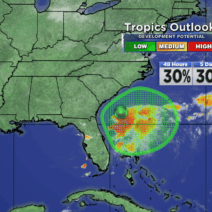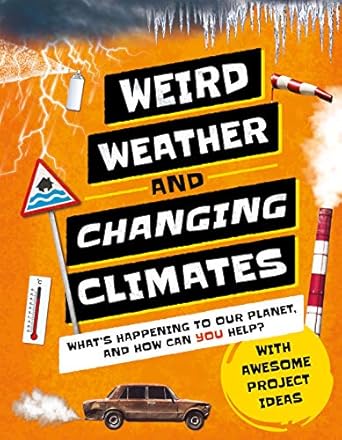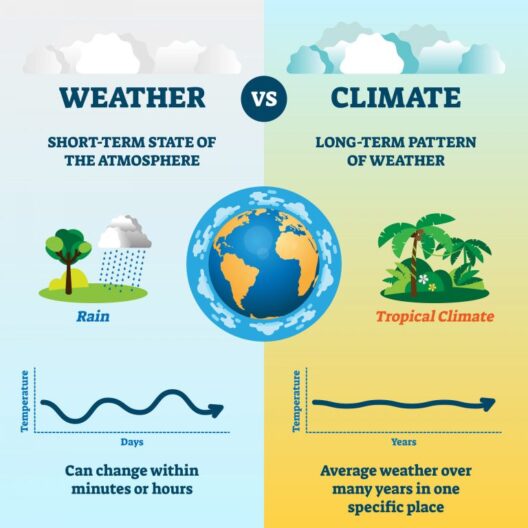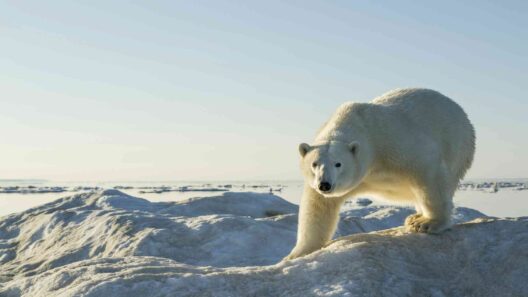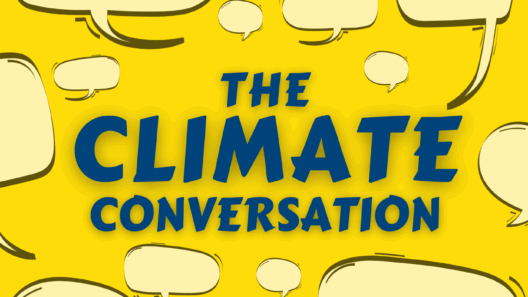Changing climates represent one of the most pressing issues confronting humanity today. The Earth’s climate has shifted dramatically over the last century, predominantly due to human activities that have led to escalating greenhouse gas emissions. This exploration elucidates the various dimensions of climate change and its tangible impacts on weather patterns across the globe.
To commence, one must delineate the concept of climate change. It is not merely a gradual alteration in weather patterns but encompasses multifaceted phenomena driven by both natural variability and anthropogenic influences. The prevailing scientific consensus indicates that activities such as burning fossil fuels, deforestation, and industrial processes have exacerbated the greenhouse effect, thereby increasing global temperatures.
As a result of these augmented temperatures, one significant consequence is the alteration of precipitation patterns. Many regions have observed a shift towards more intense and frequent rainfall, while others experience prolonged droughts. This erratic behavior of the hydrological cycle complicates water resource management and agricultural practices. Crops that once flourished in stable climates now struggle to adapt, leading to food insecurity in vulnerable populations.
Furthermore, this disruptive paradigm has generated an undue frequency of extreme weather events. Hurricanes, storms, and heatwaves are becoming more prevalent and potent, resulting in devastating economic and human tolls. Coastal regions, particularly at risk, face dual threats: rising sea levels due to melting polar ice caps and the increasing intensity of storms battering their shores. The confluence of these factors contributes to flooding, erosion, and habitat loss.
Additionally, the phenomenon of climate change is intricately linked with the realm of biodiversity. As ecosystems fluctuate in response to shifting climatic conditions, species that cannot adapt may face extinction. For instance, polar bears, reliant on sea ice for hunting, are struggling as their habitats dissolve before our eyes. The loss of biodiversity threatens ecosystem services which humanity relies upon, from pollination of plants to clean water filtration.
Moreover, the implications of climate change are not uniform across the globe. Regions are impacted differently, often exacerbating pre-existing social inequalities. Low-lying areas, typically inhabited by marginalized communities, suffer disproportionately due to their limited adaptive capacity. The migration of climate refugees is an emerging phenomenon as individuals and families flee inhospitable environments, leading to sociopolitical tensions in receiving regions.
In confronting climate change, both mitigation and adaptation strategies are necessary. Mitigation involves reducing or eliminating the sources and impacts of greenhouse gases. Transitioning to renewable energy sources—such as solar, wind, and hydroelectric power—constitutes one effective approach. Enhancing energy efficiency in transportation and infrastructure also presents substantial opportunities for reducing emissions.
On the other hand, adaptation focuses on adjusting ecological, social, or economic practices to minimize the adverse effects of climate change. Communities are adopting various strategies, including building resilient infrastructures like seawalls, developing drought-resistant agricultural techniques, and implementing smart water management systems. These measures can help buffer against the immediate impacts of climate change and secure livelihoods in the face of shifting conditions.
Education and public awareness serve as crucial components in combating climate change. Increasingly, individuals are recognizing their role in the broader environmental landscape. Grassroots movements, community initiatives, and policy advocacy play vital roles in urging governments and corporations to embrace sustainability. Comprehensive educational programs can empower future generations, equipping them to engage in solutions that address this complex issue.
In addition, technological innovations herald potential breakthroughs in our fight against climate change. From carbon capture and storage technologies that aim to sequester emissions, to advancements in battery storage for renewable energy, the trajectory of innovation is promising. These technologies, however, must be accompanied by ethical considerations regarding their implementation, governance, and accessibility.
The urgency surrounding climate change necessitates immediate and concerted global action. International agreements, such as the Paris Accord, aim to unify countries towards common climate goals. However, adherence and significant commitment remain challenging. Each nation bears a responsibility to implement tailored strategies that resonate with local conditions while aligning with global objectives.
In conclusion, the climate crisis manifests through intricate transformations in Earth’s weather systems. As patterns shift, the breadth of impacts grows, from altering precipitation and increasing extreme weather events to threatening biodiversity and exacerbating social inequities. Engaging in mitigation and adaptation, bolstering education and innovations, and fostering global cooperation are indispensable. Addressing this complex challenge is not merely an option; it is imperative for the survival of countless species, including humanity itself. To effectively navigate the crisis, fractious efforts rooted in diverse disciplines must converge towards a sustainable future.
